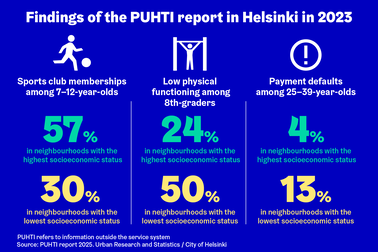
The findings form part of a larger project which commenced in April 2023 and utilises new and unique information collected by the Finnish Institute for Health and Welfare (THL). This well-being data is gathered outside the service system and provided by companies and organisations (PUHTI data). The project seeks to better understand resident wellbeing and reduce inequities between population groups—a major focus area for the city government. Analyses of the new datasets, which supplement Helsinki’s existing regional data, are also set to play a crucial role in local health policy development by incorporating information previously unavailable at the city-level. Included in this is data on the number of people participating in sports associations as well as physical fitness levels of school-aged children.
“Helsinki is a large city where the examination of averages alone seldom provides an effective basis for the promotion of well-being and health.” says Unit Manager of the Physical Activity Promotion unit Minna Paajanen from the City of Helsinki. “This new data enriches existing information on the differences between areas in the activity and physical fitness of children and young people and will help us develop and focus measures for promoting physical activity.”
Major differences between residential areas in children and young people’s participation in sports clubs
The PUHTI data on recreational and competition licenses of sports clubs is collected from the Suomisport database, maintained by the Finnish Olympic Committee and various sports associations. According to the PUHTI data, just over 40% of Helsinki residents aged 7–12 and 13–15 hold a license in at least one sport.
Rates of participation vary significantly by residential area: : There is a more than three-fold difference in participation between the least active and most active neighborhoods (20% vs 66%). The number of license holders decreases with age.
Children’s declining fitness levels and low participation in sports clubs concentrated in the same areas
The PUHTI data also includes the results of the ‘Move! Measurements’: A set of six measurements carried out at Finnish comprehensive schools (ages 7-16) to monitor the physical fitness levels students in the 5th and 8th grade. The Move! measurements collect information on basic motor skills as well as physical characteristics, such as endurance and muscle strength. Move! Found that just over one third of 5th and 8th graders in Helsinki face challenges in several of the measurement sections. When examined together with the data pertaining to sports participation, it found that poor Move! results and low participation in sports clubs are concentrated in the same areas.
“This data on the participation in sports clubs and fitness level of children and young people in different areas also contributes to the development of Helsinki’s suburban regeneration plan, the aims of which is to reduce inequalities between residential areas. The regularly updated PUHTI data enables us to monitor any changes in areas over time and plan necessary measures,” says Senior Specialist Tommi Sulander from the City Executive Office.
Physical activity and hobbies have a positive impact on the overall well-being of children
One of Helsinki’s strategic goals is to make physical activity an integral part of the daily routine of every daycare centre, school, and educational institution. Ideally, every school-aged child in Helsinki should also find a hobby, either supervised or independent, that they find enjoyable and that they can continue to engage in throughout their school studies. Meaningful hobbies provide joy and can have numerous positive effects on psychological well-being. Physical activity is an important part of the growth and development of children and young people, and it is also linked to other well-being. Engaging in a variety of physical activities and hobbies develops children’s motor skills, improves muscle strength and endurance and prevents overweight and obesity. Physical activity also supports children’s capacity to learn.
This project is supported by the Partnership for Healthy Cities – a prestigious global network of 73 cities committed to saving lives by preventing noncommunicable diseases (NCDs) and injuries. An initiative of Bloomberg Philanthropies, in partnership with World Health Organization and the global health organization Vital Strategies, the Partnership enables cities around the world to deliver a high-impact policy or programmatic intervention to reduce NCDs and injuries in their communities. For more information, visit
https://cities4health.org(Link leads to external service)


